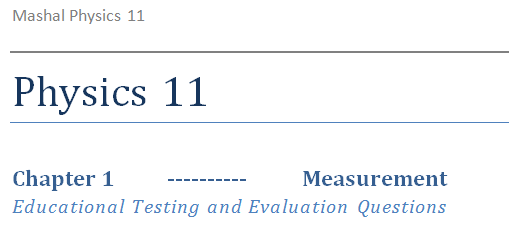
Uncertainty (error)
(33) Percentage uncertainty recorded in the measurement of the radius of the sphere is 4%. The uncertainty in the area of the sphere will be
(a) 16% (b) 4% (c) 12% (d) 8%
Solution: Surface area of a sphere = 4πr2
%age uncertainty in radius = 4%
By power rule, the %age uncertainty in the value of area of the sphere= 2*4 = 8%
(34) Percentage uncertainty recorded in the measurement of the radius of the sphere is 4%. The uncertainty in the volume of the sphere will be
(a) 16% (b) 4% (c) 12% (d) 8%
Hint: Use power rule.
(35) Percentage uncertainty recorded in the measurement of the radius of the circle is 4%. The uncertainty in the circumference of the circle will be
(a) 16% (b) 4% (c) 12% (d) 8%
(Do you know why?)
(36) The density of steel ball was determined by measuring the mass and diameter. The mass was measured with 1% error and diameter 3% of error. Error in the calculated density of the steel ball is at most:
(a) 2% (b) 4% (c) 8% (d) 10%
Hint 1: Since radius = diameter/2 . Now 2 is constant, therefore, its percentage error is 0. Applying the quotient rule for finding uncertainty in the division, d/2.
Percent uncertainty in r = Percent uncertainty in diameter + percent uncertainty in 2 = 3+0 = 3
Hint 2: Volume of the sphere is 4/3 π r3. Apply power rule to find uncertainty in volume.
Hint 3: Density = mass/volume. Apply quotient rule to find uncertainty in density.
(37) Force F is applied on mass m to produce acceleration a. Percentage uncertainty in the measurement of F is 2% and m is 1%. What is the percentage uncertainty in a.
(a) 1% (b) 2% (c) 3% (d) 4%
(38) Percentage uncertainties in the measurements of mass and velocity are 1% and 1.5% respectively. Percentage uncertainty in K.E is
(a) 1% (b) 2% (c) 3% (d) 4%
Hint: Percentage uncertainty in v2 is 2*1.5 = 3 and percentage uncertainty in mv2 = 1+2 = 3
(39) If error in the measurement of mass and length of a cube are 1% and 2% respectively, the maximum error in the measurement of the density of the cube will be
(a) 3% (b) 6% (c) 7% (d) 11%
Solution density = mass/volume ——– (A)
Now if l is the length of the cube, then volume of the cube is l3.
To find error in the volume (note that the given error is in the length of the cube)we apply the power rule of uncertainty. Therefore, percentage uncertainty in the volume is 3*2 = 6
Now using equation (A), we find the uncertainty in density by applying the quotient (division) rule.
Percentage uncertainty in the density = (1+6) = 7
(40) The maximum error in the measurement of mass and length of a cube are 2% and 3% respectively. The maximum error in the measurement of its density will be
(a) 1% (b) 5% (c) 7% (d) 11%
Dimensions
(41) The dimensions of Plank’s constant are
(a) MLT-2 (b) ML2T-1 (c) MLT-3 (d) ML2T-2
(42) The dimensions of gravitational constant are
(a) ML2T-2 (b) M-1L3T-2 (c) MLT-3 (d) ML-2T-1
Hint: Gravitational constant G = W.r2/m1m2
(43) The dimensions of torque are similar to the dimensions of
(a) Force (b) Einstein’s Energy Mass equation (c) Plank’s Constant (d) Angular momentum
Solution
Einstein energy mass equation is E = mc2 (c is the velocity of light)
In terms of dimensions mc2 = M L T-2 ——— (i)
Torque = rFsinθ
In terms of dimensions, rFsinθ = L M T-2 ————- (ii)
(Note that sin θ is the ratio of two lengths, therefore, it has no dimensions)
Comparing (i) and (ii) proves the assertion.
(44) Which one of the following is a dimensionless physical quantity?
(a)Gravitational constant (b) coefficient of friction (c) density (d) speed
(45) A car is moving with a speed of 72 km/hr. Its speed in proper SI units is
(a) 2 m/hr (b) 22 m/s (c) 0.2 km/s (d) 20 m/s
Solution:

Precision and accuracy
(46) Speed of sound at 00C is 332 m/s. A student measured the speed repeatedly and obtained the values
(1) 330 m/s (2) 329.8 m/s (3) 330.2 m/s (4) 329.75 m/s
His data is
(a) More precise, less accurate (b) More accurate, less precise
(c) Neither precise nor accurate (d) both precise and accurate
(See theory, question on precision and accuracy).
(47) A student measured the speed of sound repeatedly and obtained the data
(1) 333 m/s (2) 332.5 m/s (3) 332 m/s (4) 331.8 m/s
His data is
(a) More precise, less accurate (b) More accurate, less precise
(c) Neither precise nor accurate (d) both precise and accurate
(48) A student measured the speed of sound repeatedly and obtained the data
(1) 335 m/s (2) 330 m/s (3) 329 m/s (4) 325.5 m/s
His data is
(a) More precise, less accurate (b) More accurate, less precise
(c) Neither precise nor accurate (d) both precise and accurate
(49) A student measured the speed of sound repeatedly and obtained the data
(1) 332 m/s (2) 332.3 m/s (3) 332.8 m/s (4) 332.5 m/s
His data is
(a) More precise, less accurate (b) More accurate, less precise
(c) Neither precise nor accurate (d) both precise and accurate
